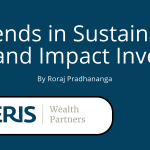Creative Destruction and Stranded Assets
By Anders Ferguson, Partner and Danya Liu, Associate
Over the next 30 years, whole swaths of the global economy will change dramatically. Innovation and technology, combined with global demand and shrinking resources, will fundamentally alter the way people do everything from getting electricity to sourcing their food.
It will no doubt be an exciting time for everyone, but it will be especially transformational for one group in particular: investors. With so much disruptive change coming, it will be easy to make a wrong bet. Or, just plain bad luck could translate into a loss of capital and opportunity.
The potential for significant losses to investors isn’t some far off scenario. As the market undergoes these changes, investors face an immediate threat known as “stranded assets.” The good news is that investors can benefit from helping sustainable technologies and companies thrive in the 21st century.
What Is A Stranded Asset?
Because we’re likely to hear the term “stranded asset” with increasing frequency, we think it’s important to understand what that means.
According to the University of Oxford, “Stranded assets are assets that have suffered from unanticipated or premature write-downs, devaluations, or conversion to liabilities and they can be caused by a variety of risks.”
The term has mostly described assets in the oil and gas industry that are losing value as renewable sources of energy become competitive with carbon-based fossil fuels. In fact, a stranded asset can occur in any industry, as the following definitions imply.
“We define a stranded asset as an asset which loses economic value well ahead of its anticipated useful life, whether that is a result of changes in legislation, regulation, market forces, disruptive innovation, societal norms, or environmental shocks.” – Generation Foundation.
“A stranded asset has lower market value than that recorded on the balance sheet because it has become obsolete in advance of complete depreciation.” – International Institute for Sustainable Development
Stranded Assets Grow Across Industries
“Stranded assets” are the product of creative destruction, a term coined by Joseph Schumpeter in 1942 to describe how innovation and new market forces destroy prevailing economic and business models.
Just in the past decade, we’ve seen creative destruction in industry after industry – and we’re likely to see more of it.
Kodak and Xerox, blue-chip companies of the last century, are now footnotes in history after digital technology rendered their products nearly obsolete. Amazon’s virtual retail operation is threatening even Walmart, the king of big-box retailers, and its global network of stores, trucks and other infrastructure. In October, Walmart’s stock lost $11 billion in a single day.
The same kind of creative destruction is happening in the transportation and hospitality industries. Uber, Lyft and other tech-inspired transportation providers are diminishing the value of the taxi industry and their huge fleet of vehicles. Likewise, Airbnb threatens the hotel and time-share industries as more people choose to rent out their homes.
The electric utility industry is also ripe for disruptive change. Barclay’s downgraded the corporate bonds of the entire electric utility industry in May 2014, according to Barron’s. The Barclay’s report said that over the next few years, “declining cost trends in distributed solar photovoltaic (PV) power generation and residential-scale power storage is likely to disrupt the status quo.”
Stranded Assets and Fossil Fuels
The previous examples demonstrate the breadth of the coming change, but it is especially problematic for the fossil fuel industry. Because the burning of fossil fuels is the single largest contributor to climate change, investors owning these assets face potentially large losses, especially as we see more stringent climate policy being enacted in key markets like California and China.
With the divestment movement gaining momentum, investors could face unwelcome outcomes if they are not realizing and addressing the risks of stranded assets in their portfolios.
To that point, California Governor Jerry Brown signed into law in October a bill requiring the $291 billion California Public Employees’ Retirement System and the $184 billion California State Teachers’ Retirement System to liquidate holdings in coal companies by July 1, 2017.
The combination of public policy and green technology is rapidly weakening the dominance of fossil fuels as an energy source. The resulting shift may eventually leave fossil fuel reserves partially unburnable – or stranded. If everyone is selling coal plants, for example, the real issue is whether you want to be the last investor owning one.
We hope to see more oil and gas companies, as well as investors, incorporate this kind of risk assessment into their strategic planning. For the time being, we believe exposure to stranded assets should be incorporate into any risk analysis.
In the long run, whether assets are related to fossil fuels, the electrical grid or real estate, investors need to address the growing risks in “stranded assets.” Failure to do so may have dire consequences.







